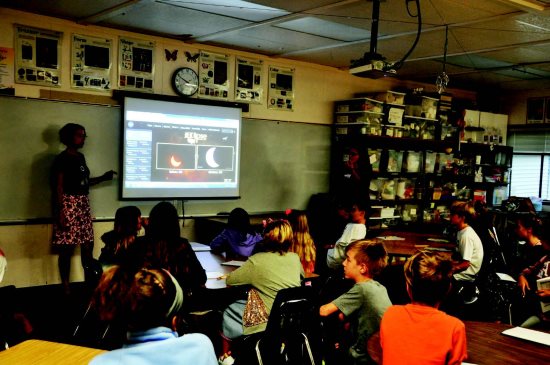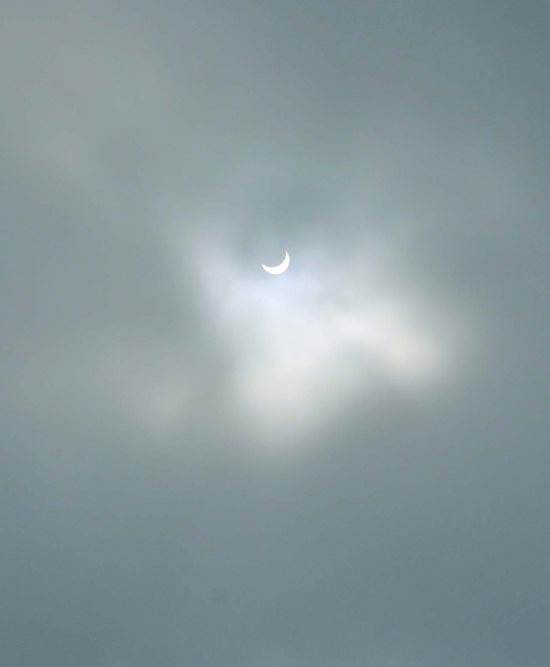| | Published August 23rd, 2017
| Eclipse Elates Elementary Earthlings
| | | By B.B. Kaye |  | | Donald Rheem Elementary School Science Aide Karen Healy (left) explains the total eclipse of the sun to a fifth-grade class while teacher Tanja Gubser (right) looks on. Gubser told her class that she observed the 1979 total solar eclipse when she was an elementary school student. Photos Andy Scheck |
Monday morning Aug. 21 in Lamorinda was characterized by a bustling in the heavens and on Earth. This first day of school brought the yearly return of early morning student traffic, wearing summer tans and gains in height and confidence, streaming in by bus, on foot, and car. And while there may have been some reluctance at exchanging lazy summer mornings for a disciplined schedule of having-to-be-there-on-time mixed with the delight of seeing old school buddies and favorite teachers again, this first day began with an exciting bonus: a chance to observe the wondrous return of a total solar eclipse.
 Although the precise path (directly underneath the transiting bodies) was far north of Lamorinda, beginning in Oregon and ending in South Carolina, making totality visible in only 14 states, angles of the eclipse were seen all over North America, South America, Africa, and parts of Europe.
Although the precise path (directly underneath the transiting bodies) was far north of Lamorinda, beginning in Oregon and ending in South Carolina, making totality visible in only 14 states, angles of the eclipse were seen all over North America, South America, Africa, and parts of Europe.
 Schools across Lamorinda readied eclipse activities for the day. At Camino Pablo Elementary School, pinhole cameras made from shoeboxes were prepared to view the event while protecting eyes against the blinding power of the sun. Volunteer William Robinson set up a spotting scope to safely project the eclipse onto a white-board. "We set up the scope here on Saturday at this time, to test positioning," he said. Teachers trained children on how to view the eclipse safely, and even added elastic headbands to ISO (International Organization of Standards) approved glasses beforehand in an abundance of caution, lest any child's glasses slip down while gazing at the powerful orb.
Schools across Lamorinda readied eclipse activities for the day. At Camino Pablo Elementary School, pinhole cameras made from shoeboxes were prepared to view the event while protecting eyes against the blinding power of the sun. Volunteer William Robinson set up a spotting scope to safely project the eclipse onto a white-board. "We set up the scope here on Saturday at this time, to test positioning," he said. Teachers trained children on how to view the eclipse safely, and even added elastic headbands to ISO (International Organization of Standards) approved glasses beforehand in an abundance of caution, lest any child's glasses slip down while gazing at the powerful orb.
 In the big multi-purpose room, Camino Pablo Principal Chris Reddam set up a big screen for students to enjoy coverage of the event, live-streamed from NASA. Fourth-grade teacher Clare Fallon took students to the school garden. "We're going to listen for the sounds of birds and insects, and try to compare them to any differences in the natural background noises they make when the eclipse occurs. Does their behavior change? Later, we'll also study how eclipses affected ancient cultures."
In the big multi-purpose room, Camino Pablo Principal Chris Reddam set up a big screen for students to enjoy coverage of the event, live-streamed from NASA. Fourth-grade teacher Clare Fallon took students to the school garden. "We're going to listen for the sounds of birds and insects, and try to compare them to any differences in the natural background noises they make when the eclipse occurs. Does their behavior change? Later, we'll also study how eclipses affected ancient cultures."
 Rheem Elementary School purchased 200 ISO approved eclipse glasses and structured lessons to ensure that maximum supervision and guidance corresponded with the learning experience, said Principal Brian Sullivan. In Tanja Gubser's fifth grade classroom, Science Aide Karen Healy spoke to students about the specifics of the historic event as they watched the total eclipse happening across the country on a big screen.
Rheem Elementary School purchased 200 ISO approved eclipse glasses and structured lessons to ensure that maximum supervision and guidance corresponded with the learning experience, said Principal Brian Sullivan. In Tanja Gubser's fifth grade classroom, Science Aide Karen Healy spoke to students about the specifics of the historic event as they watched the total eclipse happening across the country on a big screen.
 In the dawns of mankind, eclipses were watched with fear and superstition, but centuries of observation and enquiry grew into the rational system for understanding that we now possess: science. An eclipse helped to prove Einstein's theory of relativity, and eclipses are still used to forward scientific understanding. Today, equipped with modern tools of observation, children and adults alike safely enjoy the thrill and awe of witnessing these massive celestial dances.
In the dawns of mankind, eclipses were watched with fear and superstition, but centuries of observation and enquiry grew into the rational system for understanding that we now possess: science. An eclipse helped to prove Einstein's theory of relativity, and eclipses are still used to forward scientific understanding. Today, equipped with modern tools of observation, children and adults alike safely enjoy the thrill and awe of witnessing these massive celestial dances.
 Heavy cloud cover obscured Monday's event. Classes cycled from activities to watchfulness on the blacktop, hoping that skies would open for a clear sight of what everyone knew was occurring beyond the clouds. Most had gone back to their rooms at Camino Pablo when suddenly, to the marvel of a lucky small group of about 10 children, the clouds parted, revealing the eclipse in full view. "I can see it! I can see it!" students called out excitedly. Teachers sprinted to call classes out, but the clouds slid like stage curtains into place, concealing the great act again.
Heavy cloud cover obscured Monday's event. Classes cycled from activities to watchfulness on the blacktop, hoping that skies would open for a clear sight of what everyone knew was occurring beyond the clouds. Most had gone back to their rooms at Camino Pablo when suddenly, to the marvel of a lucky small group of about 10 children, the clouds parted, revealing the eclipse in full view. "I can see it! I can see it!" students called out excitedly. Teachers sprinted to call classes out, but the clouds slid like stage curtains into place, concealing the great act again.
 The last total eclipse visible in North America was 18 years ago, on Feb. 26, 1979. Six years from now, there will be an annular eclipse in which the edge of the sun remains visible as a bright ring around the moon on Oct. 14, 2023, and the next total eclipse visible in North America will happen in seven short years, on April 8, 2024. Mark your calendars!
The last total eclipse visible in North America was 18 years ago, on Feb. 26, 1979. Six years from now, there will be an annular eclipse in which the edge of the sun remains visible as a bright ring around the moon on Oct. 14, 2023, and the next total eclipse visible in North America will happen in seven short years, on April 8, 2024. Mark your calendars!


|
 | | Although an overcast sky obscured the viewing of the Aug. 21 solar eclipse in Moraga, students at Rheem and Camino Pablo elementary schools were able to catch a glimpse of the event through the clouds using special ISO glasses. | | | | | | | | | | | |




